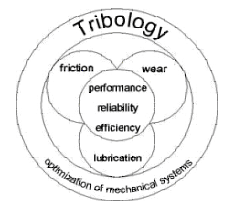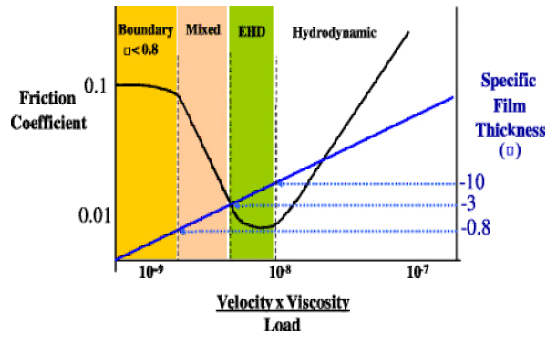Tribology comprises the fields of friction, wear and lubrication. It aims at the functional, economical and ecological optimization of motion systems. The implementation of tribological knowledge results in a reduction of wear and an optimization of friction systems.
The operational reliability of machines and installations is increased, production costs are reduced, resources and energy are saved and emissions are decreased. Tribology is the science and technology of surfaces interacting in a relative motion. It comprises the entire field of friction and wear including lubrication. It includes corresponding interfacial interactions between solids as well as between solids and liquids, consistent materials or gases. (See also DIN 50323, Part 1)
FRICTION

Friction can be defined as resistance to movement between any two surfaces in contact with each other. When friction occurs in machinery, it is not so desirable. It destroys the effectiveness of the equipment through wear, heat and shortened life. We overcome this friction by doing lubrication.
KINDS OF FRICTION
Friction can be classified into two types; solid friction which may be either sliding or rolling, and fluid friction. Sliding friction occurs when two surfaces slide over each other without lubrication as in a plain bearing or between a piston and a cylinder. Rolling friction occurs when a cylindrical or spherical body rolls over another surface without lubrication as in the modern ball and roller bearings. We require less force to overcome rolling friction than sliding friction. Hence solid friction essentially occurs when there is no lubrication.
Now to compare fluid friction with solid friction, if a film of oil is introduced between the same two surfaces, the peaks and valleys are filled up by the particles of oil. When a sufficient number of these particles of oil are placed between the two surfaces to produce a thick strong film, then the peaks and valleys slide by each other without inter-loading.
When such surfaces flat, curved or spherical, are kept apart by a fluid film, we have what we call fluid friction and these surfaces are said to be lubricated. Therefore, in lubrication, we actually reduce friction to a minimum by substituting fluid friction for solid friction.
Friction is governed by the following two laws propounded by Amontons:
1. The frictional force is proportional to normal loads.
2. Friction is independent of the size of bodies.
WEAR
Wear can be defined as undesired removal of material due to mechanical action. It is poorly understood in the scientific sense. By a conventional method wear is divided into
following main types:
1. Adhesive
2. Abrasive
3. Corrosive
4. Fatigue
Adhesive wear means damage resulting when two metallic bodies rub together without the deliberate presence of an abrasive agent.
Abrasive wear is characterised by damage to a surface by harder material introduced between two rubbing surfaces from outside. The severity of abrasive wear depends on the size and angularity of abrasive particles and also the ratio between the hardness of metal and the abrasive particles, more the tendency to wear.
Fatigue wear occurs due to cyclic stresses in rolling and sliding contacts as in gears and rolling bearings. Corrosive wear occurs due to corrosion. Rusting is a well known example.The presence of moisture, oxygen availability and dusty conditions accelerate corrosive wear.
Wear can be defined as undesired removal of material due to mechanical action. It is poorly understood in the scientific sense. By a conventional method wear is divided intofollowing main types:
1. Adhesive
2. Abrasive
3. Corrosive
4. Fatigue
Adhesive wear means damage resulting when two metallic bodies rub together without the deliberate presence of an abrasive agent.
Abrasive wear is characterized by damage to a surface by harder material introduced between two rubbing surfaces from outside. The severity of abrasive wear depends on size and angularity of abrasive particles and also the ratio between hardness of metal and the abrasive particles, more the tendency to wear.
Fatigue wear occurs due to cyclic stresses in rolling and sliding contacts as in gears and rolling bearings. Corrosive wear occurs due to corrosion. Rusting is a well known example.
The presence of moisture, oxygen availability and dusty conditions accelerate corrosive wear.
LUBRICATION
Lubrication is the reduction of friction to a minimum by replacing solid friction with fluid friction. This is achieved by introducing between two surfaces in relative motion, an ideal film of oil or sufficient amount of grease to keep the two metal surfaces separated under the speeds and loads imposed on the bearings. The most important single factor that determines the effectiveness of the oil is the viscosity of the oil.
The ratio of the squeeze film (oil film) thickness h to the surface roughness Ra determines the character of the contact between the micro asperities on the friction surfaces and the type of the lubrication regime (Fig.1):

Fig.1 Lubrication regimes

Lubrication regimes:
• Boundary lubrication (h<Ra): a constant contact between the mating surfaces.
• Mixed lubrication (h ~Ra): intermittent contacts.
• Hydrodynamic lubrication (h>Ra): no contact.
FUNCTIONS OF LUBRICANTS
Lubricants are agents introduced between two surfaces in relative motion to minimize friction. Selection and application of lubricants are determined by the functions they are expected to perform. The principal functions of lubricants are to :
a) Control friction
b) Control wear
c) Control temperature
d) Control corrosion
e) Remove contaminants
f) Form a seal (grease)
TYPES OF LUBRICANTS
Following are the commonly known types.
1. Liquid Lubricants
a) Plain mineral oil
b) Mineral oil plus additive
c) Synthetic lubricants
2. Quasi-solid Lubricants (Grease)
3. Solid Lubricants
Depending upon a typical application requirement a particular type of lubricant is chosen.
LIQUID LUBRICANTS
Liquids are generally preferred as lubricants because they can be drawn between moving parts by hydraulic action. Apart from keeping the parts separated they also act as heat carriers. In the choice of a liquid lubricant for a given application, primary consideration.
Moreover effect of temperature change on viscosity should be minimum Liquid Lubricants should in general be inert toward metal surfaces and other components.